Holidays often provide the opportunity to explore new areas for Street Photography. However, for this break, I traveled to the far reaches of Pelorus Sounds in New Zealand. Beautiful nature, but no Streets. This situation meant I could focus my camera lens on the family, and to catch up with a little holiday reading.
While hunting for reading material, I stumbled upon a collection of National Geographic magazines, with issues dating back to 1952. National Geographic is always worth a browse, even if just for the stunning photos. On this occasion, it was the camera adverts that caught my attention. Having time on my hands, I grabbed my trusty Olympus and snapped away. I discovered political incorrectness, innovations that never quite made it, and manufacturers who are not with us anymore. Where better to start than with Kodak?
Kodak and 3D Cameras
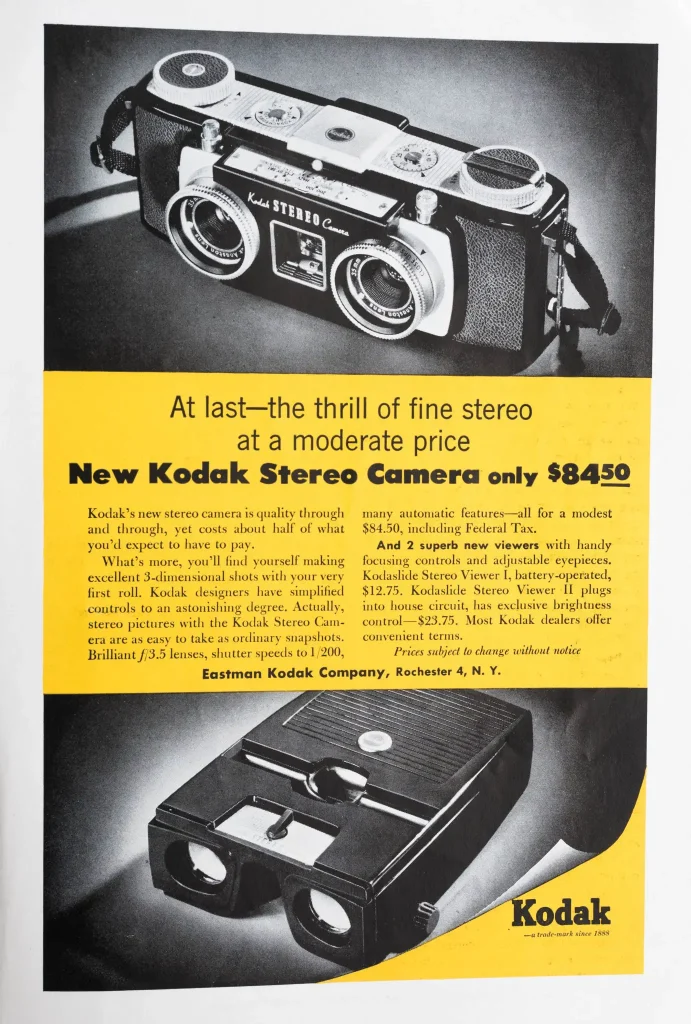
Kodak was king before digital. This advert for a ‘Stereo Camera’ demonstrates how far ahead of the game the company was. Not bad for $84.50. The ‘KodaSlide Stereo Viewer’ is a similar idea to today’s Virtual Reality headsets. While 3D photos still sound fun, it is hard to get excited about the ‘exclusive brightness control’. Kodak ended the production of The Stereo Camera 1952. Today, these models can still be picked up on eBay for less than $100 and would be an awesome addition to anyone’s compact camera collection. The shutter speed went up to 1/200, which would have been ideal for the following product.
Ansco Film in the 1960’s.
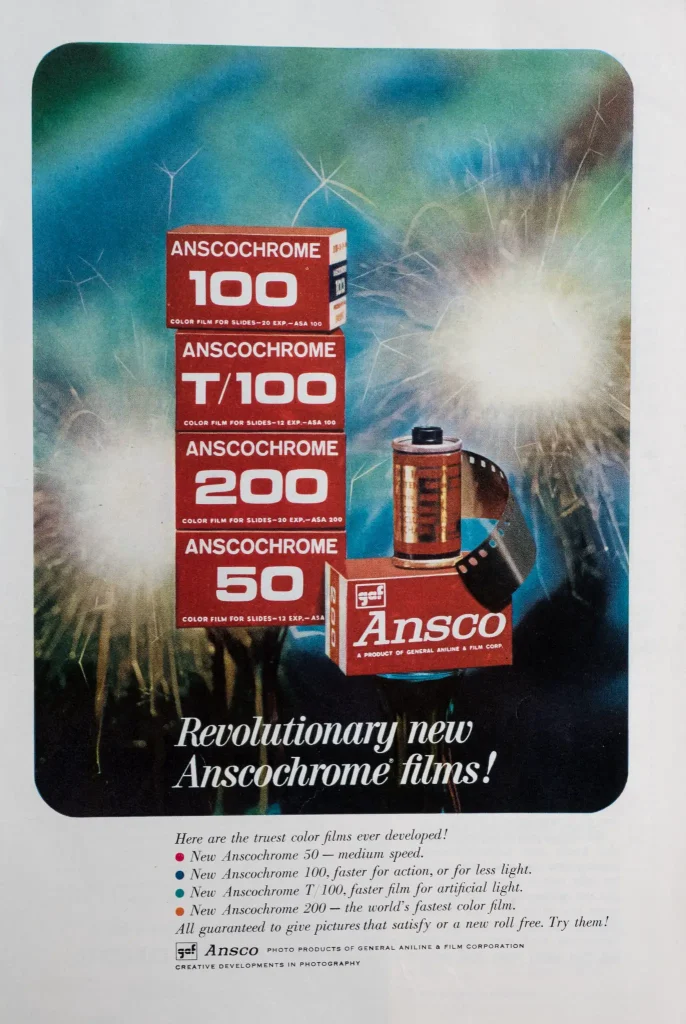
Ansco was a company large enough to place an advert in National Geographic for their Anscochrome film, but where are they now? Maybe they went bankrupt following the offer to, ‘give pictures that satisfy or a new roll free.’ Ansco states their 200ISO film was fastest in the world, outpacing anything manufactured by Kodak. However, while this advert claims that Anscochrome were, ‘the truest color films ever developed,’ Kodachrome remained the medium of choice.
Selfies
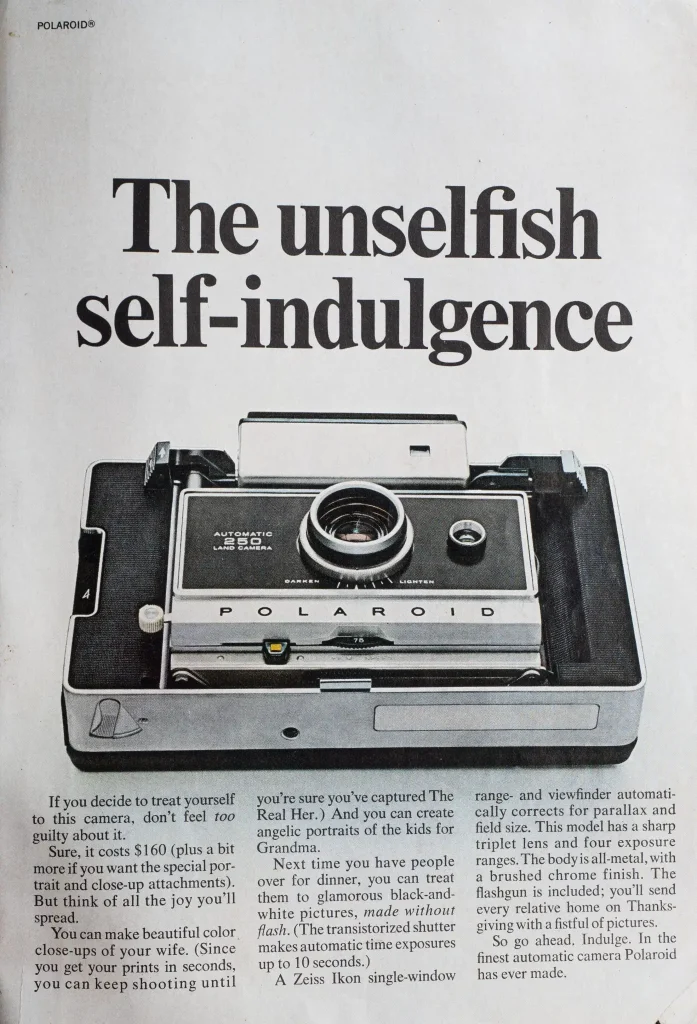
With flipped selfie screens and follow-me-drones, adverts continue to promote self-indulgence. I would happily indulge in purchasing this Polaroid Camera. With an, ‘all metal, brushed chrome finish’, it would fit in with the smartest hipster crowd. Maybe friends would be impressed with the black and white photos ‘made without flash’, or possibly the ‘beautiful color close-ups’ of my wife? This instant camera certainly looks better than the plastic models available today. While on the subject of looks, Minolta managed something completely different.
Minolta
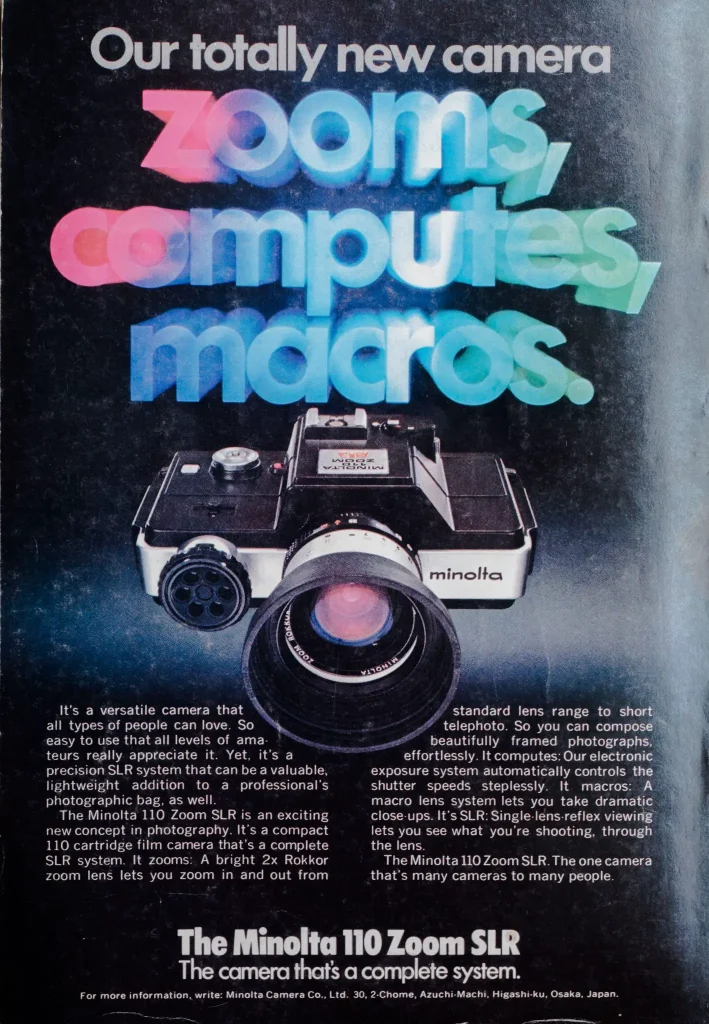
Minolta SLRs are still sought after and have an excellent reputation. Camera designs are slow to change, but here Minolta evidently tried to break the mold. Why have I never seen one of these, and where can I download that font? The Minolta 110 Zoom is how the future should have looked, yet production ended in 1979, and its successor looked much more like a conventional SLR. Maybe it was the small 110 cartridge film that stopped this from being the success it could have been. On the topic of size…
Small Camera, Large Format
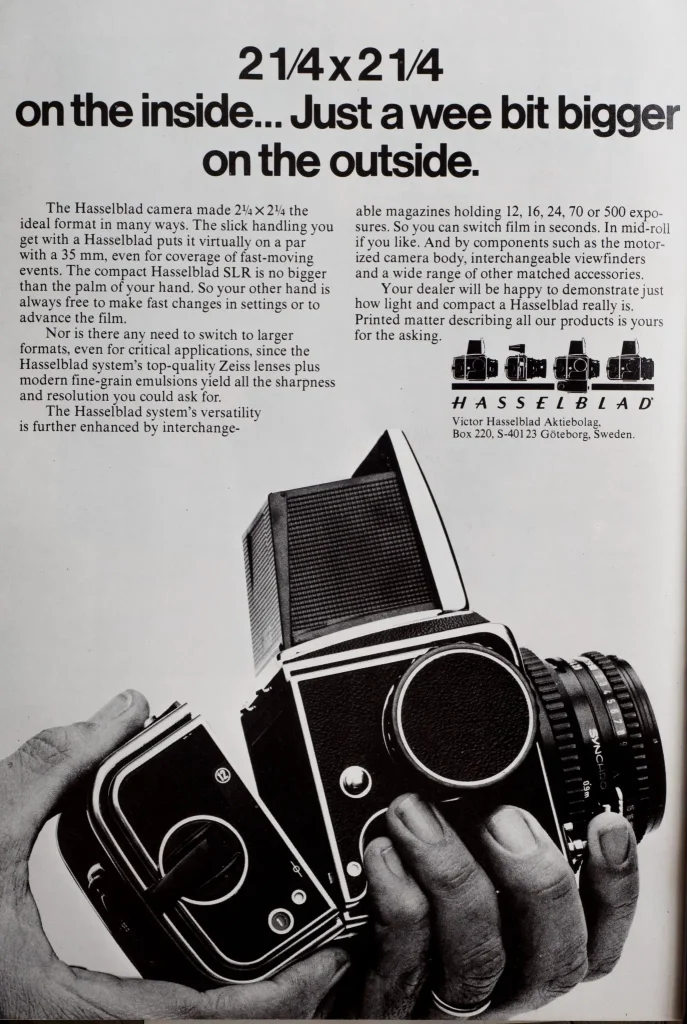
While trends change, some selling points remain the same. The argument that, ‘you don’t need to switch to larger formats’ is as relevant now as it was then. With a quality Zeiss lens attached, who are we to argue? The promotion of accessories appears to be a format that has never been out of fashion. Hasselblad state this camera could take cartridges of film with 500 exposures, this appeals to the Street Photographer in me. However, processing that many photos would me an expensive chore. I particularly love how this advert offers ‘printed matter’ for the taking.
More than just taking pictures
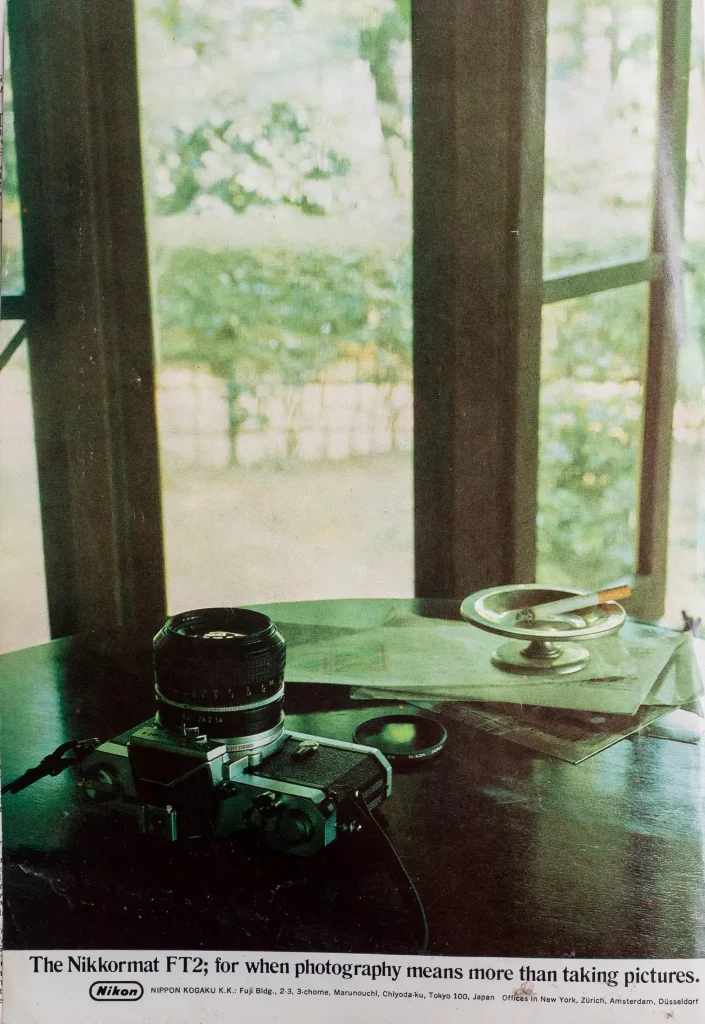
Apparently, in 1976 photography was also about having a quiet smoke after a hard day’s filming. The use of cigarettes is one advertising technique that I am guessing will not reemerge anytime soon. Check the film processing chemicals are not flammable before lighting up!
I took these photos while sat on an old sofa outside my family’s holiday home. I think the collection is a significant slice of history. These adverts motivated me to head out and purchase a box of film for my much neglected Nikon F80 and my compact Lo-Fi special, an Olympus Superzoom 800s. What amazes me is how good some of these cameras remain today. These hunks of metal were built to last. If you have an old camera and you would like to see one of the original adverts I may well have it, feel free to contact me via my website, www.pagespics.com.
Keep Clicking, Chris
Share this post:
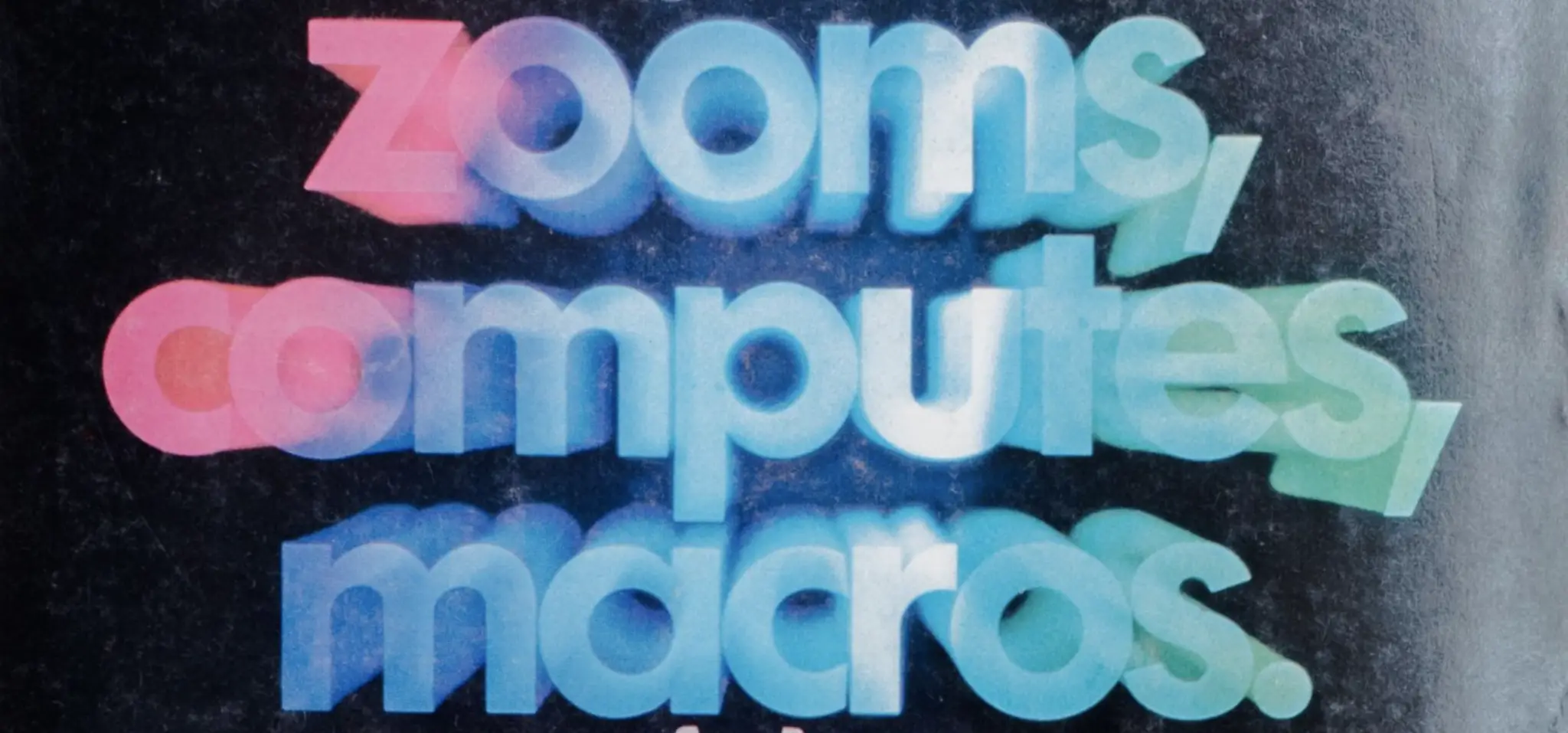








Comments
Hamish Gill on A National Geographic Find – by Chris Page
Comment posted: 26/02/2018
Comment posted: 26/02/2018
James T on A National Geographic Find – by Chris Page
Comment posted: 27/02/2018
Terry B on A National Geographic Find – by Chris Page
Comment posted: 27/02/2018
Even ignoring the European based stereo cameras that preceded the Kodak, there were at least three US manufacturers selling stereo 35mm cameras a few years before this Kodak, the Stereo Videon, 1949, the Stereo Contura and Stereo Revere 33, both 1950, thus dispelling your thoughts that Kodak was ahead of the game.
Regarding Ansco film, they did go on to make a 500 ASA (ISO) and a friend showed me some of his slides - grain like golf balls! But I suppose a lot of fun in the right circumstances.
I have a number of 110 cameras in my collection, including the two Minolta reflexes. Considering how relatively poor the format was, it amazes me the lengths to which some camera manufacturers went with some of their models. Their top models are exquisitely made and I'd say over-engineered for the format. This first attempt by Minolta at an slr is interesting today purely by its design, and it must be the biggest 110 camera ever made. I suspect that not many would care for lugging it around. It uses mirrors, not a pentaprism, so the image is darker than one might expect. The MkII is a much better proposition, being smaller and better specified. Canon introduced the 110 ED, a slab of a camera that visually looks not unlike the many simple pocket 110's. But it is high spec and is fitted with an f2 lens, and a coupled rangefinder to boot. Some of the top of the range Agfa's with their "Pocket" series are interesting, too.
But my two favourites are the tiny Rollei A 110 and, the equally small, Pentax Auto 110, a true slr with interchangeable lenses. The quality of the Pentax lenses is superb and can be adapted for use with m4/3 as their imaging circle covers the sensor. Unfortunately, they can only be used wide open at f2.8 as the aperture is contained within the body. But they all have manual focus.
chris on A National Geographic Find – by Chris Page
Comment posted: 01/03/2018
Comment posted: 01/03/2018
Chris Pattison on A National Geographic Find – by Chris Page
Comment posted: 04/03/2018